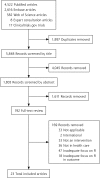Interventions Addressing Food Insecurity in Health Care Settings: A Systematic Review
- PMID: 31501207
- PMCID: PMC7032918
- DOI: 10.1370/afm.2412
Interventions Addressing Food Insecurity in Health Care Settings: A Systematic Review
Abstract
Purpose: Based on the recognition that food insecurity (FI) is associated with poor health across the life course, many US health systems are actively exploring ways to help patients access food resources. This review synthesizes findings from studies examining the effects of health care-based interventions designed to reduce FI.
Methods: We conducted a systematic review of peer-reviewed literature published from January 2000 through September 2018 that described health care- based FI interventions. Standardized mean differences (SMD) were calculated and pooled when appropriate. Study quality was rated using Grading Recommendations Assessment Development and Evaluation criteria.
Results: Twenty-three studies met the inclusion criteria and examined a range of FI interventions and outcomes. Based on study design and sample size, 74% were rated low or very low quality. Studies of referral-based interventions reported moderate increases in patient food program referrals (SMD = 0.67, 95% CI, 0.36-0.98; SMD = 1.42, 95% CI, 0.76-2.08) and resource use (pooled SMD = 0.54, 95% CI, 0.31-0.78). Studies describing interventions providing food or vouchers reported mixed results for the actual change in fruit/vegetable intake, averaging to no impact when pooled (-0.03, 95% CI, -0.66 to 0.61). Few studies evaluated health or utilization outcomes; these generally reported small but positive effects.
Conclusions: Although a growing base of literature explores health care-based FI interventions, the low number and low quality of studies limit inferences about their effectiveness. More rigorous evaluation of FI interventions that includes health and utilization outcomes is needed to better understand roles for the health care sector in addressing FI.
Keywords: food insecurity; public health; social determinants of health; systematic review.
© 2019 Annals of Family Medicine, Inc.
Figures


Similar articles
-
Clinical-Community Partnerships to Identify Patients With Food Insecurity and Address Food Needs.Prev Chronic Dis. 2017 Nov 16;14:E113. doi: 10.5888/pcd14.170343. Prev Chronic Dis. 2017. PMID: 29144894 Free PMC article.
-
Screening and Addressing Food Insecurity at Free Clinics: A Scoping Review.Res Sq [Preprint]. 2025 May 13:rs.3.rs-6270596. doi: 10.21203/rs.3.rs-6270596/v1. Res Sq. 2025. PMID: 40470181 Free PMC article. Preprint.
-
Food Insecurity in US Military Veterans.Food Nutr Bull. 2020 Dec;41(4):399-423. doi: 10.1177/0379572120963952. Food Nutr Bull. 2020. PMID: 33356537 Review.
-
Population-based interventions addressing food insecurity in Australia: A systematic scoping review.Nutr Diet. 2020 Feb;77(1):6-18. doi: 10.1111/1747-0080.12580. Epub 2019 Oct 8. Nutr Diet. 2020. PMID: 31593624
-
Food Insecurity Screening in Pediatric Clinical Settings: A Caregivers' Perspective.Matern Child Health J. 2020 Jan;24(1):101-109. doi: 10.1007/s10995-019-02785-6. Matern Child Health J. 2020. PMID: 31494801
Cited by
-
Changes in Food Insecurity Among Individuals Using a Telehealth and Nutrition Platform: Longitudinal Study.JMIR Form Res. 2022 Oct 25;6(10):e41418. doi: 10.2196/41418. JMIR Form Res. 2022. PMID: 36282563 Free PMC article.
-
Food Insecurity and Pediatric Obesity: a Double Whammy in the Era of COVID-19.Curr Obes Rep. 2020 Dec;9(4):442-450. doi: 10.1007/s13679-020-00413-x. Epub 2020 Oct 16. Curr Obes Rep. 2020. PMID: 33064269 Free PMC article. Review.
-
Association of a primary care-based mobile food pantry with child body mass index: A propensity score matched cohort study.Pediatr Obes. 2023 Jun;18(6):e13023. doi: 10.1111/ijpo.13023. Epub 2023 Mar 20. Pediatr Obes. 2023. PMID: 36939408 Free PMC article.
-
Interventions to Address Food Insecurity Among Adults in Canada and the US: A Systematic Review and Meta-analysis.JAMA Health Forum. 2021 Aug 6;2(8):e212001. doi: 10.1001/jamahealthforum.2021.2001. eCollection 2021 Aug. JAMA Health Forum. 2021. PMID: 35977189 Free PMC article.
-
Association Between Self-reported Health-Related Social Needs and Acute Care Utilization Among Older Adults Enrolled in Medicare Advantage.JAMA Health Forum. 2022 Jul 8;3(7):e221874. doi: 10.1001/jamahealthforum.2022.1874. eCollection 2022 Jul. JAMA Health Forum. 2022. PMID: 35977222 Free PMC article.
References
-
- Coleman-Jensen A, Rabbitt MP, Gregory CA, Singh A. Household food security in the United States in 2016. U.S. Department of Agriculture, Economic Research Service; https://www.ers.usda.gov/publications/pub-details/?pubid=84972. Published Sep 2017.
-
- Rose-Jacobs R, Black MM, Casey PH, et al. Household food insecurity: associations with at-risk infant and toddler development. Pediatrics. 2008; 121(1): 65-72. - PubMed
Publication types
MeSH terms
LinkOut - more resources
Full Text Sources
Miscellaneous
